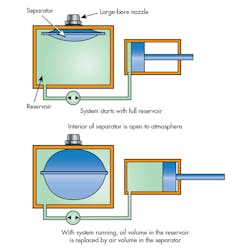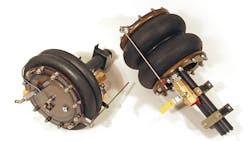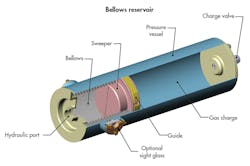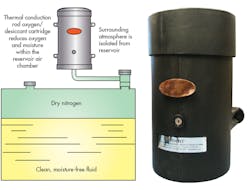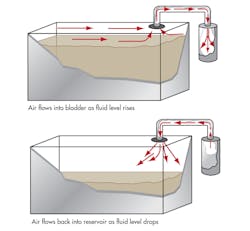Keeping Fluid Clean in the Reservoir
Download this article in PDF format.
Content has been updated as of Oct. 25, 2021.
The atmosphere surrounding a hydraulic system sometimes is underestimated as a source of dirt and moisture that can infiltrate hydraulic systems—usually through the reservoir breather. The oil level continually rises and falls as cylinders extend and retract, and system cycles occur. As the oil level rises, air pushes out of the reservoir, and as it drops, ambient air is drawn in through the breather.
Thousands of microscopic airborne particles can pass through the breather filter with every machine cycle. These particles can get into the fluid and damage sensitive hydraulic components as they travel through the system.
A similar condition exists with water. Moisture in the air can also enter the reservoir through the breather. The water may remain a vapor as long as the hydraulic fluid in the reservoir is at operating temperature. But when the system is shut down, temperature drops, and water can condense on the internal surfaces of the reservoir. The liquid water is then free to flow into the hydraulic fluid and also promote corrosion of the reservoir walls’ inner surfaces.
Water contamination in the hydraulic fluid may deplete some additives and react with others to form corrosive byproducts. On top of that, it can increase air entrainment potential and lead to hydraulic pump cavitation.
Fortunately, most hydraulic system designers are aware of these potential problems and compensate by using a breather-filter combination to keep large airborne particles out of the reservoir. However, breather filters are not designed to exclude moisture.
Industry has answered by offering breather filters incorporating a desiccant to also dry the air entering the reservoir. These products help reduce the amount of dirt and moisture entering the reservoir, but they don’t eliminate it. Furthermore, they must be replaced periodically, so the cleaner, dryer air comes at the cost of additional maintenance.
Although the variety of the reservoir filtration products available works to minimize the effects of dirt and moisture contamination, other unconventional products are available to provide a more-effective solution. These work by providing a physical barrier between the interior of the reservoir and the surrounding area. At least one solution goes a step further by reducing the amount of oxygen within the reservoir, thereby inhibiting oxidation of the fluid.
Internal Volume Compensator
Unless the air is first filtered and dried, contaminants can enter the system as the fluid level changes and air is drawn into the reservoir. A sealed or pressurized reservoir is able to solve that problem, but it increases system cost and complexity. A simpler solution, offered by Pronal USA, is a volume compensator. It consists of an inflatable bladder made of heavy synthetic fiber, coated and vulcanized inside and out with an oil-compatible elastomer.
A volume compensator expands to fill the void inside a reservoir as fluid level changes, keeping ambient air from coming in direct contact with the fluid. (Courtesy of pronal-usa.com)
The bladder fits inside the reservoir and inflates to occupy any voids as the dropping fluid level would otherwise create a vacuum. As fluid returns to the reservoir, its pressure pushes the air out and deflates the compensator. Because the interior of the compensator contains ambient air, but its exterior is housed within the sealed reservoir, no ambient air contacts or contaminates the hydraulic fluid.
If the top of the reservoir is cluttered with valves or other components, the compensator can be placed outside the reservoir and connected with tubing. As a closed system, it still keeps ambient air from coming into direct contact with the hydraulic fluid in the reservoir. The compensator also can be configured so that the reservoir is able to work while submerged under water.
Variable-Volume Compensator
For applications such as mobile equipment that must be transported to remote locations, a variable-volume reservoir (VVR) becomes a good option to replace a conventional reservoir. It reduces reservoir weight and space by a ratio of 20:1 or more, according to Sobacor Inc. Being sealed and airless, the VVR isolates the system’s hydraulic fluid from external solid contaminants and moisture.
A variable-volume reservoir, which isolates hydraulic fluid from external contaminants, significantly reduces reservoir size and weight. Typical expanded and retracted positions are shown. (Courtesy of www.variablevolumereservoir.com)
VVRs can be used in other applications where space and weight are concerns. Because the fluid they contain is never exposed to the environment and its contaminants, it will last three to four times longer than in a conventional reservoir, according to Sobacor. The VVR’s smaller volume also enables the use of biodegradable fluids at a significantly reduced cost, with resulting environmental benefits as well.
Metal Bellows Reservoir
Technically, a gas-charged accumulator could be used as a hydraulic reservoir. A piston accumulator is susceptible to internal leakage, especially as the seals age. Bladder accumulators tend to leak as the bladder material becomes less flexible over time. A more robust alternative for many applications is a metal-bellows-type reservoir, designed and manufactured by Senior Bellows.
A metal-bellows reservoir incorporated into a pressurized housing provides contamination-free operation, high reliability, and resistance to temperature extremes or corrosive environments. (Courtesy of www.metalbellows.com)
The all-welded metal construction of a bellows reservoir eliminates the leakage problems associated with traditional accumulators. Welded construction provides contamination-free operation, maintenance-free service, high reliability, long life, and being impervious to temperature extremes or corrosive environments. The elastomeric seals of a conventional accumulator may shed particles into the hydraulic fluid—not so with a metal-bellows reservoir.
A welded metal bellows is manufactured by stamping individual diaphragms from metal foil stock. Pairs of diaphragms are welded together at the inside diameter to create a single convolution. Convolutions are stacked together and welded at the outside diameter to create the flexible metal-bellows capsule. This creates an expandable/collapsible, all-metal fluid chamber.
To make the reservoir, the completed metal bellows is welded into a reservoir housing or pressure vessel. The housing or vessel may be spring-energized or gas-charged. The gas-tight, hermetic construction of the metal-bellows reservoir makes it possible to use a helium gas charge, which can offer performance superior to air or nitrogen., By contrast, helium may not be used with a piston or bladder reservoir because of possible leakage.
Metal bellows reservoirs typically are manufactured from high-strength stainless steel. However, titanium is often used for lightweight aircraft applications, and high-nickel super alloys also may be used in corrosive or high-temperature environments.
Less Dirt, Water, and Oxygen
Another solution converts an open breather system to an expandable bladder system, and passes air within the reservoir through a desiccant dryer and oxygen absorber to remove moisture and prevent corrosion. The OilN2, invented by John A. Paoluccio, P. E., of Inventive Resources Inc., combines a bladder that physically isolates the air in a hydraulic system’s reservoir with a thermal conduction rod that attracts and captures oxygen and moisture already in the reservoir into a replaceable cartridge.
The OilN2 incorporates a bladder to isolate air within the system as well as a combination thermal conduction rod and cartridge with oxygen absorber and desiccant dryer media. (Courtesy of www.oiln2.com)
Once the OilN2 has been connected to either the reservoir’s breather vent port or remotely mounted and connected, it physically isolates the air in the system from ambient conditions. The air still existing in the reservoir, however, typically contains airborne dirt, moisture, and oxygen.
The OilN2 protects the system by altering the interior environment of the reservoir to a clean, dry nitrogen state. Oxygen and moisture molecules in the internal air are attracted and captured by a combination thermal conduction rod and cartridge with oxygen absorber and desiccant dryer media. The attracted oxygen molecules undergo a chemical reaction that locks them in the cartridge. This reduces the oxygen in the air, leaving a high concentration of nitrogen. The easily replaceable cartridge may last for years in a tight system.
A cool spot is formed on the thermal conduction rod, which causes condensation of oxygen and moisture. The rod works continuously, even when the hydraulic system itself is idle. However, it is more aggressive when equipment is turned off and cools after each operating cycle. When the system operates and heats the oil, water molecules are driven from the oil and enter the isolated air chamber. Depending on the system, return on investment can occur in just a few months, according to the inventor.
Hydraulic Fluid Isolator
A variation on the bladder principle is Parker Hannifin’s KleenVent reservoir isolator. It uses an external elastomeric bladder as a “lung” that allows changes in gas volume in the reservoir, but prevents mixing with outside air.
In operation, when the hydraulic reservoir is filled, the air on top of the oil goes into the bladder. When the oil level in the reservoir goes down, the bladder pushes air back into the reservoir. This containment approach completely eliminates the potential of pulling in outside air. The atmosphere acts against the outside of the bladder isolator, while internally the same air is exchanged continuously between the reservoir and the bladder.
The Parker KleenVent reservoir isolator uses an elastomeric bladder as a “lung” that allows changes in gas volume in the reservoir, but prevents mixing with outside air. (Courtesy of www.parker.com/KleenVent)
This separation allows the system to operate normally, while preventing ingestion of airborne contaminants. Unlike conventional breather-vent filters, the reservoir isolator provides positive separation without clogging, making it maintenance-free. With proper bladder material selection, these units are compatible with virtually any type of hydraulic fluid. They are available in standard capacities up to 100 gallons, and can be used in parallel to achieve even larger capacity.
Actuators are also sources of fluid contamination in hydraulic systems. Check out "Filler-Breather Adapter Simplifies Hookups" for one solution that addresses the problem.

